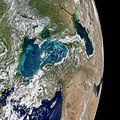Fayl:Turquoise Swirls in the Black Sea.jpg

Size of this preview: 600 × 600 pixels. Başqa çözüm: 240 × 240 pixels | 480 × 480 pixels | 768 × 768 pixels | 1.024 × 1.024 pixels | 2.048 × 2.048 pixels | 7.000 × 7.000 pixels.
Kerçek fayl (7.000 × 7.000 piksel, fayl büyükligi: 16,71 MB, MIME çeşiti: image/jpeg)
Faylnıñ keçmişi
Faylnıñ kerekli anki alını körmek içün tarihqa/saatqa basıñız.
| Tarih ve saat | Kiçik resim | En × boy | Qullanıcı | İzaat | |
|---|---|---|---|---|---|
| şimdiki | 08:55, 2017 s. iyünniñ 12 |  | 7.000 × 7.000 (16,71 MB) | Originalwana | {{Information |Description ={{en|1=Most summers, jewel-toned hues appear in the Black Sea. The turquoise swirls are not the brushstrokes of a painting; they indicate the presence of phytoplankton, which trace the flow of water currents and eddies. O... |
Fayl qullanıluvı
Bu saife qullana bu fayldı:
Umumiy fayl qullanıluvı
Bu vikilerde bu fayldı qullana:
- ar.wikipedia.org qullanım
- بوابة:محتوى متميز
- ويكيبيديا:صور مختارة
- ويكيبيديا:صور مختارة/الفضاء والكون
- ويكيبيديا:صور مختارة/الفضاء والكون/نظرة إلى الخلف
- بوابة:محتوى متميز/محتويات
- بوابة:محتوى متميز/محتويات/صور مختارة
- بوابة:محتوى متميز/الرئيسية
- علوم الأرض ناسا
- ويكيبيديا:يوم ويكيبيديا العربية التاسع عشر
- مستخدم:أيوب/يوم ويكيبيديا العربية التاسع عشر
- ويكيبيديا:يوم ويكيبيديا العربية التاسع عشر/تنفيذ الأهداف
- ويكيبيديا:ترشيحات الصور المختارة/البحر الأسود
- ويكيبيديا:صورة اليوم المختارة/أغسطس 2023
- قالب:صورة اليوم المختارة/2023-08-31
- be-tarask.wikipedia.org qullanım
- bn.wikibooks.org qullanım
- cs.wikipedia.org qullanım
- cv.wikipedia.org qullanım
- dz.wikipedia.org qullanım
- en.wikipedia.org qullanım
- fa.wikipedia.org qullanım
- fa.wikibooks.org qullanım
- frp.wikipedia.org qullanım
- fr.wikipedia.org qullanım
- gl.wikipedia.org qullanım
- he.wikipedia.org qullanım
- hu.wikipedia.org qullanım
- hy.wikipedia.org qullanım
- hy.wikibooks.org qullanım
- it.wiktionary.org qullanım
- ka.wikipedia.org qullanım
- ko.wikipedia.org qullanım
- lbe.wikipedia.org qullanım
- lb.wikipedia.org qullanım
View more global usage of this file.




